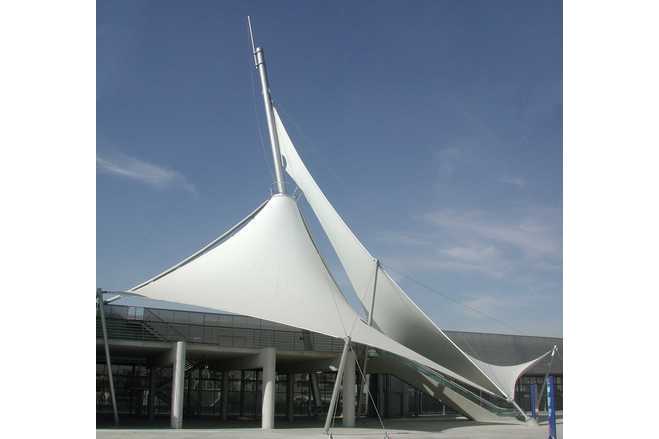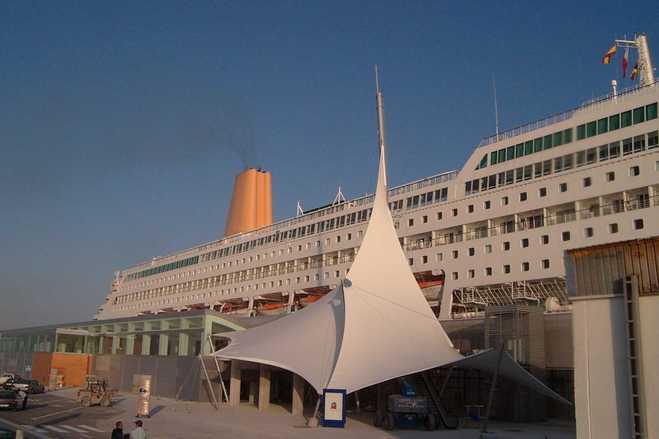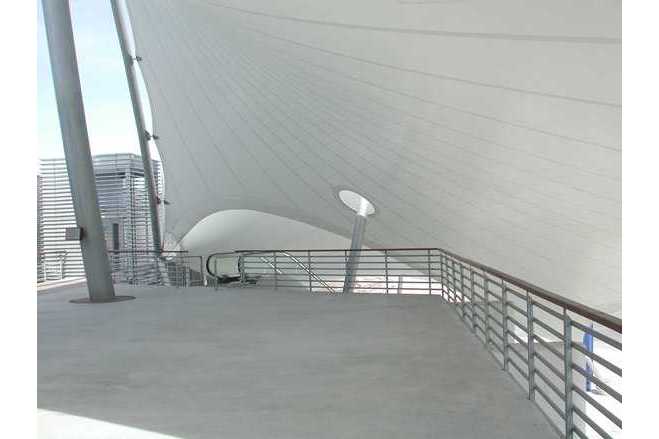ANCHORED ON LAND: Maritime Station entrance building in Alicante harbour
General information
-
Home page
http://www.arquitextil.net
-
Location address
Alicante harbour
-
Location country
Spain
-
Year of construction
2003
-
Name of the client/building owner
Alicante maritime administration
-
Function of building
Hybrid buildings
-
Degree of enclosure
Hybrid structure
-
Climatic zone
Mediterranean - mild winters, dry hot summers
-
Number of layers
double-layer
-
Primary function of the tensile structure
- Sun protection
Description
The original Maritime Station was built in the sixties with a very impressive structure made of concrete shells. In 2003 it was completely renovated, and as part of this renovation, a new entrance building was planned. Finally, the option of a light structure as a hall for a heavy building was decided. The situation of the roof, on a breakwater, almost surrounded by the sea as part of the harbour, conditioned it in two different ways:On one side, the design should simulate the masts and yards of a Tall Ship.In order to get this, the hole structure is hanged of a mainmast (35m height) in the middle and small masts on the border. The geometry of the tent, one half-cone as a mainsail and one irregular paraboloid as a gaff-topsail, and the details of the hole structure are constant references to ships (top basket in the mainmast, six small masts some of them as a kind of jib-booms, stainless clews of the sails, and so). On the other side, the structural analysis should face expected wind loads of almost 180 Km/h, making the structure to be light but much more resistant than others we have done before.In this way, membrane used was Ferrari 1302 Fluotop T2, enough for this loads and good for dirt-resistance and saline environment while steel used in masts and arches was high resistant A52b/S355 JR.The half-cone is hanged under the top basket in the main mast, and it has two fixed borders ?curved steel tubes- and three more fixed points on masts with four free borders -cables- or bolt-ropes. The paraboloid is anchoraged to the mainmast in a fixed border with plates, and five more points to each mast with bolt-ropes (cables) between them. The mainmast is stabilised by cables in order to reduce flexion due to eccentric forces transmitted from the membranes. These cables (grouped in two families, one on top of the mainmast and other on the second membrane fixation ?stay and shrouds-) are fixed to masts and finally to foundations (which were design for seismic loads).The bottom of the mainmast is a spherical articulation designed to fix the position of the mast with the upper family of cables, and later on the mast is anchoraged in its middle point with a steel crown to the concrete slab which is passed through by the mast. This way, it works embedded and not articulated. The finishing of main floor is a wooden deck, as a new reference to the nautical origin of this Tall ship anchored on land.
Description of the environmental conditions
Sun protection in the waiting area of the station
Material of the cover
-
Cable-net/Fabric/Hybrid/Foil
Fabric
-
Type (code)
Ferrari 1302 Fluotop T
-
Weight (g/m2)
1350
Main dimensions and form
-
Covered surface (m2)
600
-
Maximum height (m)
35
-
Total length (m)
30
-
Total width (m)
20
-
Form single element
Anticlastic
-
Form entire structure
Anticlastic
Duration of use
-
Temporary or permanent structure
Permanent
-
Design lifespan in years
21-30
Involved companies
-
Engineers
THEMA (Guillermo Capellan)
-
Contractors
-
Suppliers
SERGE FERRARI
Editor
-
Editor
Jose Maria Lastra




